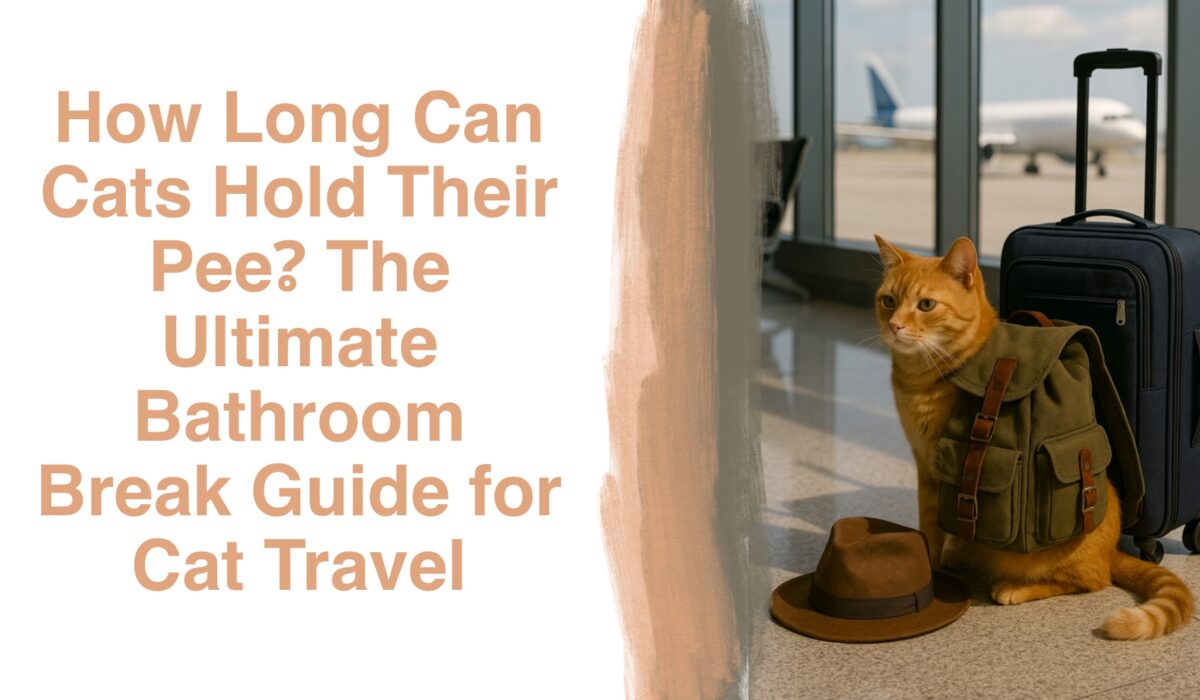How Long Can Cats Hold Their Pee? The Ultimate Bathroom Break Guide for Cat Travel
Spoiler alert: It’s longer than you think, but shorter than you’d hope
Let’s talk about something every cat owner traveling with their furry friend needs to know but might be too embarrassed to ask: how long can cats actually hold it? Whether you’re planning a cross-country road trip or just trying to get through a 3-hour car ride to grandma’s house, understanding your cat’s bathroom needs is crucial for a successful journey.
The Short Answer (That’s Not So Simple)
Healthy adult cats can typically hold their urine for 24-48 hours if absolutely necessary, but that doesn’t mean they should. Just like humans, cats are much more comfortable when they can relieve themselves regularly. For travel purposes, you should plan bathroom breaks every 4-6 hours, especially for longer journeys.
But here’s where it gets interesting – stress, age, health conditions, and individual personality all play huge roles in how long your specific cat can comfortably hold it.
Why Cats Are Actually Pretty Good at This
Cats evolved from desert animals, which means they’re naturally efficient at conserving water and concentrating their urine. This evolutionary advantage means they don’t need to pee as frequently as dogs or even humans. A typical house cat will urinate 2-4 times per day under normal circumstances.
However, when traveling, several factors can change this routine:
Stress Response: Some cats actually pee less when stressed (their body goes into conservation mode), while others have the opposite reaction and need to go more frequently.
Dehydration: Cats often drink less water when they’re anxious or in unfamiliar environments, which can lead to more concentrated urine and longer intervals between bathroom breaks.
Holding Pattern: Many cats will instinctively “hold it” when they’re in an unfamiliar environment, waiting until they feel safe to use a litter box.
Age Matters More Than You’d Think
Kittens (Under 6 months): These little guys have tiny bladders and less control. Plan for bathroom breaks every 2-3 hours, and don’t be surprised if accidents happen.
Adult Cats (6 months – 7 years): This is your sweet spot. Healthy adult cats can comfortably hold their urine for 4-6 hours while traveling, sometimes longer if needed.
Senior Cats (7+ years): Older cats may have kidney issues, arthritis that makes getting in and out of litter boxes painful, or other health conditions that affect their bathroom habits. Plan for more frequent breaks and be extra patient.
The Travel Bathroom Break Strategy
For Car Trips Under 4 Hours: Most cats can make the journey without a bathroom break, but it’s kind to offer one if you’re stopping anyway. Keep a portable litter box in the car just in case.
For 4-8 Hour Journeys: Plan one bathroom break halfway through. Find a quiet rest stop, set up a portable litter box in your car (with doors closed for security), and give your cat 10-15 minutes to do their business.
For Epic Road Trips (8+ Hours): You’ll want to plan bathroom breaks every 4-6 hours. Consider breaking the journey into multiple days if possible – it’s less stressful for everyone involved.
Setting Up the Perfect Travel Bathroom
The Portable Litter Box Setup: Invest in a collapsible travel litter box or use a disposable cardboard one. Bring familiar litter from home – this is not the time to try a new brand. Set it up in your car with all doors closed, or find a quiet, enclosed area if you’re at a rest stop.
The Security Factor: Never set up a litter box in an open area where your cat could bolt. Even the most docile house cat can panic in unfamiliar surroundings. Your car with all doors closed is usually the safest option.
The Patience Game: Don’t expect your cat to immediately use the travel litter box. They might need a few minutes to sniff around and feel safe. Some cats prefer privacy, so consider covering their carrier with a blanket while they decide what to do.
When Things Don’t Go According to Plan
Accidents Happen: If your cat has an accident in their carrier, don’t panic. Clean them up gently with pet-safe wipes, change their bedding, and make sure they’re not showing signs of distress or illness.
The Stress Pee: Some cats will urinate immediately when put in a carrier due to fear. This is normal (though frustrating). Extra bedding and waterproof carrier liners are your friends here.
The Stubborn Holder: If your cat absolutely refuses to use the travel litter box but seems comfortable otherwise, don’t force it. Most healthy cats can hold it longer than we’d like them to, and they’ll go when they really need to.
Red Flags to Watch For
Straining Without Results: If your cat is trying to urinate but nothing’s coming out, this could be a sign of a blockage – a medical emergency that requires immediate veterinary attention.
Blood in Urine: Always a cause for concern, especially when combined with travel stress.
Excessive Drinking or Urinating: Could indicate diabetes, kidney disease, or other health issues.
Complete Refusal to Eat or Drink: While some cats won’t eat or drink much while traveling, complete refusal for more than 24 hours is concerning.
Pro Tips from Experienced Cat Travelers
Start Training Early: If you know you’ll be traveling, start getting your cat used to a travel litter box at home. Place it in different rooms so they learn it’s still their bathroom even when it’s not in the usual spot.
Bring Extra Everything: Extra litter, extra bedding, extra cleaning supplies. Trust us on this one.
Know Your Cat: Some cats are bathroom divas who need everything to be perfect, while others are more adaptable. Adjust your strategy accordingly.
Stay Calm: If your cat has an accident or seems stressed about bathroom breaks, remember that your anxiety will only make things worse. Stay patient and positive.
The Bottom Line
Most healthy adult cats can hold their urine for much longer than is comfortable, but as responsible pet owners, we shouldn’t ask them to. Plan for bathroom breaks every 4-6 hours on long trips, bring a portable setup, and be patient with the process.
Remember, every cat is different. Some become travel pros who use their portable litter box like it’s no big deal, while others prefer to wait until they reach their destination. Both approaches are normal, and with time and practice, most cats adapt to travel routines.
The goal isn’t perfection – it’s keeping your cat comfortable and healthy while getting from point A to point B. And who knows? You might discover that your cat is actually a pretty great road trip companion, bathroom breaks and all.



